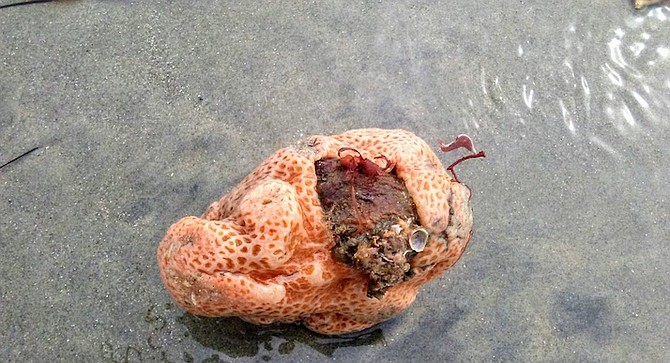 Facebook
Facebook
 X
X
 Instagram
Instagram
 TikTok
TikTok
 Youtube
Youtube

Several tourists and locals were in for a creepy encounter in Ocean Beach last week, as “this thing” washed ashore.
“What is it? Daddy what IS it?” I heard a young girl of about seven years old ask as I was approaching the blob. “I touched it, am I going to die?” She asked. Assuring her and her father that she wasn’t going to die, I said it was probably a piece of live coral and not to worry.
But I automatically started researching ‘dolphin brain’ on my phone. Several others in the area insisted it was a sea sponge. As the tide took the strange blob back out to sea, I scratched my head — this thing was soft and squishy with an interior that appeared bloody.
Scripps Scientist Greg Rouse confirmed it is not a brain, sea sponge or piece of live coral: “It is a sea squirt, Aplidium californicum, or sea-pork, which are common in intertidal rock pools.”
According to Wikipedia: Its ‘a compound tunicate forming sheets, mounds or slabs on rocks and other hard substrates. The tunic is jelly-like in consistency, 1 to 3 cm thick and a shiny yellow, orange, reddish-brown or a translucent white color...each one is subdivided into a thorax, an abdomen and a post-abdomen.
But the coolest thing about it?
This animal is actually a distant relative to humans in that the classification falls in the subphylum called Tunicates, which includes all animals with dorsal nerve cords and notochords.
Last month, in South Carolina, a woman shared photos via Facebook of “strange blobs of flesh…seen all over the beach” which were later identified as ‘sea pork.’


Several tourists and locals were in for a creepy encounter in Ocean Beach last week, as “this thing” washed ashore.
“What is it? Daddy what IS it?” I heard a young girl of about seven years old ask as I was approaching the blob. “I touched it, am I going to die?” She asked. Assuring her and her father that she wasn’t going to die, I said it was probably a piece of live coral and not to worry.
But I automatically started researching ‘dolphin brain’ on my phone. Several others in the area insisted it was a sea sponge. As the tide took the strange blob back out to sea, I scratched my head — this thing was soft and squishy with an interior that appeared bloody.
Scripps Scientist Greg Rouse confirmed it is not a brain, sea sponge or piece of live coral: “It is a sea squirt, Aplidium californicum, or sea-pork, which are common in intertidal rock pools.”
According to Wikipedia: Its ‘a compound tunicate forming sheets, mounds or slabs on rocks and other hard substrates. The tunic is jelly-like in consistency, 1 to 3 cm thick and a shiny yellow, orange, reddish-brown or a translucent white color...each one is subdivided into a thorax, an abdomen and a post-abdomen.
But the coolest thing about it?
This animal is actually a distant relative to humans in that the classification falls in the subphylum called Tunicates, which includes all animals with dorsal nerve cords and notochords.
Last month, in South Carolina, a woman shared photos via Facebook of “strange blobs of flesh…seen all over the beach” which were later identified as ‘sea pork.’
Comments